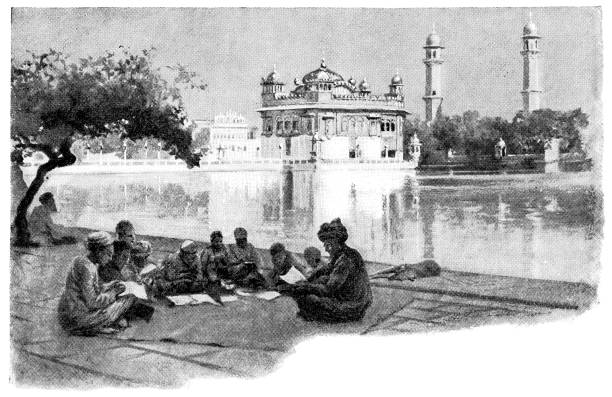Amritsar historically also known as Rāmdāspur and colloquially as Ambarsar, is a city in northwestern India and is located in the Majha region of the Indian state of Punjab. The city is situated 217 km (135 mi) northwest of state capital Chandigarh and 455 km (283 miles) northwest of New Delhi, the national capital. It is near Pakistan, with the Wagah Border being only 28 km (17.4 mi) away. Amritsar has been chosen as one of the heritage cities for HRIDAY – Heritage City Development and Augmentation Yojana scheme of Government of India. Amritsar is home to Harmandir Sahib, popularly known as “The Golden Temple,” one of Sikhism’s most spiritually significant and most-visited gurudwaras. The city is also known for its wooden chessboards and chess pieces manufacturing industry.
Brief History of Amritsar:
The Bhagwan Valmiki Tirath Sthal situated at Amritsar is believed to be the Ashram site of Maharishi Valmiki, the writer of Ramayana. As per the Ramayana, Sita gave birth to Lava and Kusha, sons of lord Rama at Ramtirth ashram. Large number of people visit Ramtirth Temple at annual fair. Nearby cities to Amritsar, Lahore and Kasur were said to be founded by Lava and Kusha, respectively. During Ashvamedha Yagna by Lord Rama, Lava and Kush captured the ritual horse and tied Lord Hanuman to a tree near to today’s Durgiana Temple.
Founding of Amritsar City:
Guru Ram Das Ji, the fourth Sikh guru is credited with founding the holy city of Amritsar in the Sikh tradition. Two versions of stories exist regarding the land where Guru Ram Das Ji settled. In one based on a Gazetteer record, the land was purchased with Sikhdonations, for 700 rupees from the owners of the village of Tung. According to the Sikh historical records, the site was chosen by Guru Amar Das Ji and called Guru Da Chakk, after he had asked Guru Ram Das Ji to find land to start a new town with a man-made pool as its central point, After his coronation in 1574, and the hostile opposition he faced from the sons of Guru Amar Das ji , Guru Ram Das ji founded the town named after him as “Ramdaspur“. He started by completing the pool, and building his new official Guru centre and home next to it. He invited merchants and artisans from other parts of India to settle into the new town with him. The town expanded during the time of Guru Arjan Dev Ji financed by donations and constructed by voluntary work. The town grew to become the city of Amritsar, and the pool area grew into a temple complex after his son built the gurdwara Harmandir Sahib, and installed the scripture of Sikhism inside the new temple in 1604. The construction activity between 1574 and 1604 is described in Mahima Prakash Vartak, a semi-historical Sikh hagiography text likely composed in 1741, and the earliest known document dealing with the lives of all the ten Gurus.
Weather and Climate of Amritsar:
Amritsar is located at 31.63°N 74.87°E with an average elevation of 234 metres (768 ft).
Amritsar has a semiarid climate, typical of North-western India and experiences four seasons primarily: winter season (December to March) with temperature ranges from 0 °C (32 °F) to about 15 °C (59 °F), summer season (April to June) where temperatures can reach 42 °C (108 °F), monsoon season (July to September) and post-monsoon season (October to November). Annual rainfall is about 681 millimeters (26.8 in). The lowest recorded temperature is −3.6 °C (25.5 °F), was recorded on 9 December 1996 and the highest temperature, 48.1 °C (118.6 °F), was recorded on 22 May 2013.
Transport:
Air
Amritsar hosts Sri Guru Ram Dass Jee International Airport. The airport is connected to other parts of India and other countries with direct international flights to cities.
Rail
Amritsar railway station is the main terminus station. The Samjhauta Express runs from Delhi through Amritsar to Lahore in Pakistan.
Road
Amritsar is located on the historic Grand Trunk Road (G.T Road), also known as NH 1 now renumbered as National Highway 3. Additionally, NH 54 (Old NH15), NH 354 and NH 503A connect Amritsar to other parts of state and rest of India
Rs 450,000,000 is being spent to expand the Amritsar-Jalandhar stretch of G.T. Road to four lanes. In 2010, elevated road with four lanes connected to the National highway for better access to the Golden Temple has been started.
Amritsar MetroBus
Amritsar has a bus rapid transit service, the Amritsar Metrobus which was launched on 28 January 2019. 93 fully air-conditioned Tata Marcopolo buses are used for the service connecting places like Golden Temple, Jallianwala Bagh, Guru Nanak Dev University and Khalsa College, India Gate Amritsar.


0 Comments on History of City Amritsar – asrhelpost.com